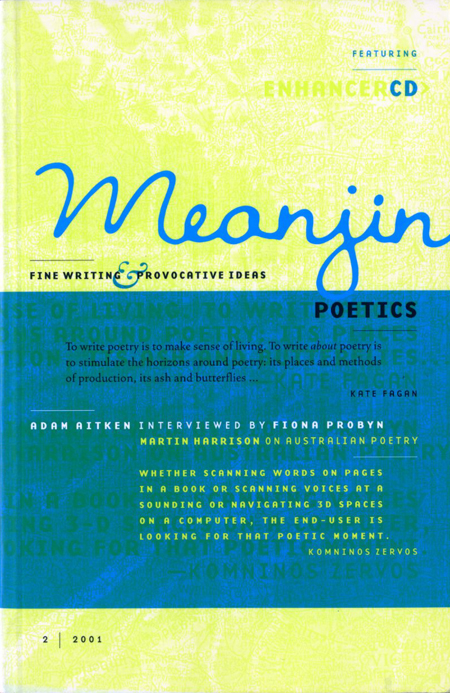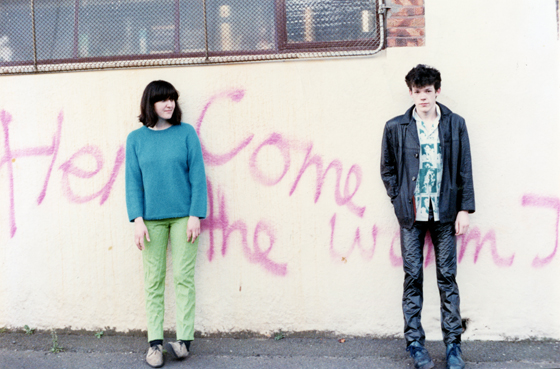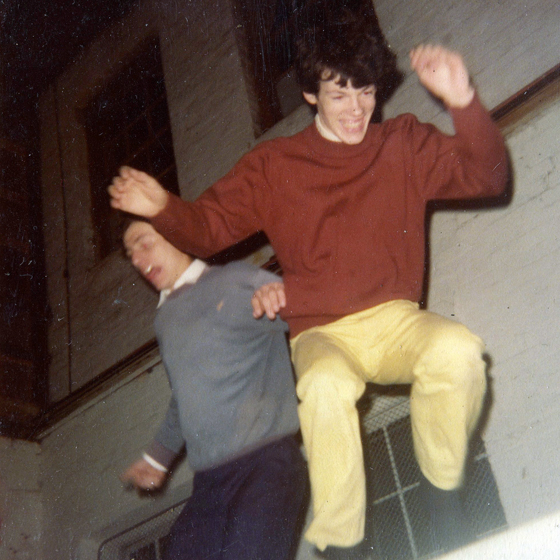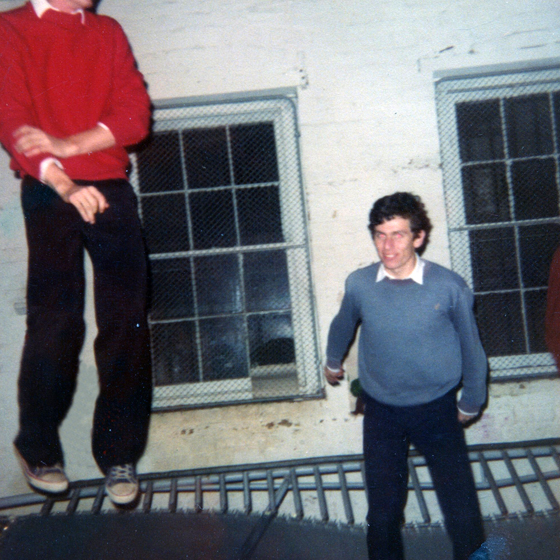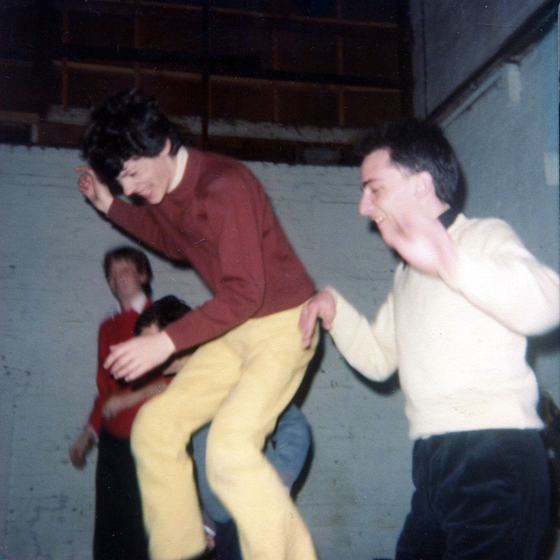→ ↑ →: Diacritics fpr Local Consumption"
published in Meanjin, Vol.60 No.2 Melbourne © 2001by Darren Tofts
The weird and wonderful world of → ↑ →
As a teenager growing up in Reservoir in the i97os, the closest thing to collaboration I was aware of was backing up your mates in a punch-up. Street violence was an accepted part of life in the northern suburbs. When the Keon Park sharps were hanging around Northland shopping centre on a Friday night, a blue with the West Heidelberg boys was on. A beer at the Croxton Park Hotel would more than likely end up with a visit from the Lebanese Tigers. I lived on the border of Reservoir (and that' s 'rez-a-vor') and East Preston, just around the corner from the notorious Crevelli Street, a location into which one ventured cautiously and, advisedly, with at least two mates (it earned the moniker of 'Little Chicago' in the 1950s as a testament to its fearsome reputation ). Even Chopper Reed, then a mad thug from Thomastown, had the good sense not to go it alone when he took on the Crevelli boys.
The sharpies had defined suburban style with their Thornbury-made 'Connie' cardigans (short for the label Continental), hand-made Acropolis shoes and tight-cropped haircuts (somewhere between a skinhead and a truncated mullet ). Much later in the '7os I began to be aware of another signature of style: → ↑ →.
This pervasive cipher became for me a recognisable coordinate of another expression of Melbourne cultural life — one that also embraced collaboration as an essential way of doing things in the context of the loca. Its author, Philip Brophy, was known to me as someone who played in a strange band whose repertoire included Issac Hayes, Glenn Miller, David Bowie, Henry Mancini and Brian Eno. That band → ↑ → (pronounced like an admonitory click of the tongue: → ↑ →), would shift personnel around to suit particular performance concepts (such as the 'all girl' line-up for the 1978 'Feminimalism'), breaking up the idea of the classic ensemble, but at its core, along with Brophy, were Ralph Traviato, Leigh Parkhill, Jane Stephenson and Maria Kozic. Maria Kozic, a practising artist in her own right, shared Brophy's fascination with Pop Art and popular culture in all its manifestations, especially the repetitive use of iconic Pop images (Bowie, Warhol screen-prints ) — a trope that would become a signature feature of her solo career as a mixed-media artist.
Now, don't worry, this is not going to be some nostalgic, autographical narrative about living in the seventies. I merely opened with these vignettes to inscribe something of the context in which I first became aware of Philip Brophy and his work, and the dynamics that have maintained my interest in it for more than twenty years. My initial affinities with his work were very local, and the specifics of that locality were important in declaring the presence of an intellectual avant-garde in an unlikely environment. This was an intellectualism as much 'out of place' in Carlton as it was in Reservoir: "In fact, the enemy to me always was Carlton and everything it represented," Brophy commented recently. 'Whenever I hear those Sydney/Melbourne debates, all I think of is Bondi surf guards fighting bearded Drum-smoking bookworms and how I wish they'd kill each other off." [1]
→ ↑ → signalled the presence of an altogether different kind of cultural attitude, committed not only to the production of art but determinedly interested in drawing attention to the spectacle of'culture, to culture as spectacle, its disguised modes of construction, assumptions and concealed meanings.
Thinking back on it now, that cryptic symbol was more than the unspeakable name of a band. The problem of knowing how to pronounce it - even knowing that it was something to be spoken — was the germ of a combinatory poetic involving signs and acts of interpretation. Like Thomas Pynchon's Trystero in The crying of lot 49, it was "a hieroglyphic sense of concealed meaning, of an intent to communicate". It was an incursion into the spaces of local consumption, an encoded performance of ideas to do with identification, recognition and cultural memory. It was a kind of poetic manifesto, an idea-kit for thinking about culture, sign systems and modes of understanding. Donald Fagen and Walter Becker preferred to think of Steely Dan as more a concept than a band and the same could be said of → ↑ →. But unlike Steely Dan, whose name you could pronounce without knowing anything about their music, → ↑ → engendered an ingenious culture of familiarity.
To know what this cryptic signature stood for you had to be a consumer. In this, → ↑ →'s collaborative poetics had not escaped the astute gaze of some of Australia's key cultural critics of the early 1980s. Paul Taylor, writing in the inaugural issue of Art + Text, invoked Roland Barthes' notion of the 'second degree' to explain the dynamics of dislocation, defamiliarisation and recognition involved in → ↑ → performances:
"In the realm of the 'second degree', those abstract relations which connect the artist and spectator to the artwork are organised around a sense of participation wherein the spectator's role is openly affective. There is a recognition that the work is incomplete without the spectator and that its meaning exists externally — in the space of language and culture."
Brophy knew only too well that the inflections of diacritics have to be learned before they can be applied. To name the band you had to collaborate in the pervasive circuit of reference, performance, publication and multimedia events that constituted the → ↑ → cultural program.
I-You-We
Decoding and decipherment, as interventions into cultural systems of representation and meaning, were coming into critical vogue in the late 1970s as imported critical paradigms such as structuralism and semiotics were beginning to have an impact on critical practice. Common to the poetics of → ↑ → and media and cultural critics of the time was an interest in exploding the ideological and textual contracts that relate us to cultural practices in apparently naturalistic ways. There was a conspicuous seriality to the events that bore the imprimatur of → ↑ →, from dramatic, polyphonic graphic art, buzzing with cross-cultural echoes from Japanese manga and American horror films to dramatic experiments with structure and duration, such as a four-hour dramatic adaptation of Andy Warhol's novel A. → ↑ → events were a sonic, tactile collision with extreme ideas.
By the early 1980s → ↑ → had developed into a prolific, independent publishing, recording and media production matrix. Its various production arms — Present records, Regeneration video, Dumb films, Stuff publications, Autist graphics — were facets of a poetics of local consumption in which verve, imagination and reflexive invention were the key ingredients. The local, whether it was Bundoora, Northcote, St Kilda or Sydney, was wherever you and the performance were at the moment: an aesthetic experience that was "subjective and immediate and which depend [ed] crucially on the spectator's receptivity to a species of subcultural and often autobiographical signs". [2]
Nice Noise
Branded by the rock press as exponents of 'new music', somewhere between punk, electronic music and pop, → ↑ → were quickly identified with the rarefied and esoteric experimentation associated with the 'organ factory' musicians (David Chesworth, Essendon Airport, Laughing Hands ) who congregated at the Clifton Hill Community Music Centre in the early '8os. But the subtleties of diacritical work were perhaps lost on the Melbourne cultural scene as it struggled to understand what could possibly emerge after punk. Ashley Crawford, writing in The Virgin Press in 1981, hit the nail on the head: "Semiotics is not the kind of fascination the average rock band would indulge in." [3] → ↑ → events were stylised cabarets of formalist irony, minimalism and appropriation: the performance of performance as performance. → ↑ → recordings, made between 1979 and 1980, were no less self-conscious or deconstructive in their poetics; the eponymous EP of 1980 invites us to "Experience the pleasure of the pleasure of listening." We do not simply listen to the music, but rather experience "the nature of Melody". The first EP, Venetian Rendezvous (1979), is an ironic tribute to blandness, an exploration of muzak, the music of "the well-mannered synthesizer". Subtitled "Popular music as subversive pleasure", it is → ↑ →'s first essay on method.
Stuffing
Problems of comprehending what → ↑ → were on about were akin to the very problematics of enunciation they were interested in exploring, and by which they were ambivalently represented in their elusive siglum. Their own deliberately vague, antipodal description of their operations as 'somewhere between art and pop'4 is suggestive of their indifference (in the Duchampian sense ) to pure or decorous ideas of production. As Brophy observed in a 1978 interview in RAM:
"What makes us different from other bands is that we don't specialise in any particular area ... We aren't musicians, or artists, or actors or anything like that. We deliberately attempt not to just be the one thing. We simply try to work in as many different areas as possible, music, film and video. What we do next is always pretty arbitrary. People usually approach us so our work is aimed at specific situations and occasions. If we have been doing music for a while we'll try and turn around and make a film next." [5]
A similar creative indifference underpinned their approach to subjects and material. Brophy's motto for Stuff (the publication arm of → ↑ →) was "stuff that's interesting to write about", and this freedom to work with whatever interested → ↑ → members was behind the great diversity of their performance, film, video and published work. McKenzie Wark, whose earliest work was published in Stuff recognised the significance of this omni-attentive aesthetic sensibility:
"Phil taught us to go find stuff to think and write about, rather than just take the handouts from class or the hand-me-downs of the canon. Stuff was a beautiful example of form and content both being thought through together in the art of publishing ... Thinking through the stuff' of culture, and making stuff out of that thinking — and writing — and putting it back in circulation." [6]
Stuff, along with The Virgin Press, Art + Text, On The Beach and Tension provided an engaged and lively forum for 'new styles of discussion'. [7]With writers including Philip Brophy, Adrian Martin, Paul Taylor, McKenzie Wark, Catharine Lumby, Paul Foss, Meaghan Morris, Rex Butler and Ted Colless, we see the beginnings of the avant-scene in Australian writing on culture that preceded the institutionalised cultural studies paradigm of the late '8os and '9os. The idea of an 'anything goes' approach to cultural criticism, often used to discredit the practice, is quite different from Brophy's own, which may more accurately be described as 'anything might potentially go'. This is an important distinction, since the latter situates writing as an authentic, empirical exploration of its subject, an attempt to essay a subject. [8] The essay, regardless of the topic, becomes an open text, an abductive process of inquiry, involving risk-taking and chance, taking the reader on an unpredictable, audacious and even unsettling journey through untried terrain, rather than safely guiding them towards closure through the deductive, reductio ad absurdum of premise, argument, conclusion. As Brophy himself observed in a Stuff essay of 1983, "The end to anything is a tautological event." [9]
Two exemplary essays are worth exploring here. 'Horrality' is one of Brophy's most acclaimed and reproduced. [10] Subtitled 'The textuality of contemporary horror films', it does not purport to be a comprehensive survey of the genre, but rather attempts to come to terms with the inflections of difference that mark off those films made between the early 1970s and the mid-1980s and those made during the heyday of the Universal, Hammer and Toho studios. Consistent with the potent, glyphic shorthand of diacritics, Brophy's incursion into the idiom of difference is through the invention of a compound word, the neologism that gives the essay its title: "Horrality: horror, textuality, morality, hilarity ... 'Horrality' celebrates the precise nature of what constitutes the films of this re-birth as texts." As a neologism, it "does not so much 'mean' something as ... describe a specific historical juncture, a cultural phase that is as fixed as the semantic accuracy of the words." An incisive attention to the inflections of difference is gleaned from the experience of the films themselves:
"'Horrality' is too blunt to bother with psychology — traditionally the voice of articulation behind horror — because what is of prime importance is the textual effect, the game that one plays with the text, a game that is impervious to any knowledge of its workings. The contemporary Horror film knows that you' ve seen it before; it knows that you know what is about to happen; and it knows that you know it knows you know. And none of it means a thing, as the cheapest trick in the book will still tense your muscles, quicken your heart and jangle your nerves ... A nervous giggle of amoral delight as you prepare yourself in a totally self-deluding way for the next shock. Too late. Freeze. Crunch. Chill. Scream. Laugh." [11]
Brophy is not interested in catalogues or inventories of effect. Horrality is not a mechanism for asking questions but rather an empirical barometer of affect.
"What is this thing called 'disco'?", published in Art + Text in 1981, is an index of Brophy's aesthetic of finding a use for stuff, for the ambient signs of everyday life: "Disco needs critical investigation for the sole reason that there is so much of it around, and so much of it in areas outside of itself." [12] This essay is one of the earliest examples in Australian cultural criticism of that most distinctive of post-critical forms, the autocritique. Brophy is interested in exploring the expedient margins between disco, as a set of cultural practices, and the name 'disco'; he is interested in disco not as a phenomenon that we can talk about, but rather as a language that we need to attempt to understand. This marginal zone is a semiotic space in which Brophy finds himself unavoidably located:
"When I talk about disco, I would be referring to the meaning of the word, which for communication purposes would entail the definition of it primarily as a musical type. When I talk about the name of 'disco' I am talking about the power behind using that word, a power that embodies a knowledge of quite definite effects and reactions resultant from uttering the word. Disco, as a defined body, is a mystery — such is the nature of style when it comes to specific definition. Disco, as a word that means little but implies a lot, is not such a mystery, because the traces of disco — the marks of its absence — are painfully perceptible."
This essay reaches no conclusions, nor does it taper off irresolutely. Brophy may not be able to define disco or theorise the hostility it seemed to attract; in attempting to think about its constitution as a musical style and the politics of its reception, he eschews looking for origins and historical explanations. He allows 'disco' to resonate as opinion, samples, examples, traces and quotations, without trying to classify it: "Disco, like any other musical style or form ... is a mutant, and is furthermore the offspring of a whole history of mutants." The idea that closure was something to be put off for a perpetual later, was at the time revolutionary in Anglo-American criticism, let, alone Australian critical writing. → ↑ → explored the question of disco through a series of multimedia iterations; as a recording by the occasional spin-off band 'Asphixiation', installation/performance and video recording of the performance Aural/Oral Risk, (1982). In other words, multimedia alterity: "No matter which way you look at it, 'you can't stop the music'."
Gestures against texts
In one of his many aphoristic moments, Dr Johnson observed that "Curiosity is one of the permanent and certain characteristics of a vigorous intellect." Curiosity and vigour were indelible features of Brophy's writing and, indeed, the entire → ↑ → project. They were certainly characteristics of his important and decisive collaborations with Adrian Martin in the early 1980s. Brophy found in Martin an equallyaudacious thinker and rapacious explorer of culture in its totality. Martin has commented on the irresistible collaborative force of Brophy's view of the entire "system of the world, culture, humanity, life, art, film ... the lot", describing it as an impressive ability to "galvanise people together into creative action through the example of his own focus, dedication and energy". [13] The image of galvanising is apposite, with its suggestions of chemical reactions and electricity stimulating fusions and surprising results. As well as being a collaborator, Martin has written a number of crucial reviews of essays on and interviews with → ↑ →. These pieces contextualised their work for the curious and the befuddled alike and were important in introducing them to different audiences — in particular, the innovative and highly theoretical contemporary art scene of the early '80s.' [14] In more recent years he has been an adviser and regular contributor to Brophy's landmark international conferences on film sound, Cinesonic.
At a time of tremendous change and excitement in Australian arts criticism, Brophy's and Martin's collaborative writing kick-started a style that moved with ease and ingenuity between music, theory, film, text and performance. Their critical writing of the early to mid '8os, along with other figures of the so-called Australian 'new wave', provided the long-awaited riposte to Patrick McCaughey's assessment of the dullness of Australian art criticism and his blunt assertion that "Art criticism doesn't produce the sages of modern culture that contemporary literature spawns so abundantly." [15] Brophy and Martin were less interested in emulating mentors than breaking the mould and starting again. Their writing disclosed an irreverent attitude in tune with the punk sensibility that was still exerting its slagstained afterglow, an attitude that had no time for decorum or the niceties of form (an impatience suggested in the title of → ↑ →'s retrospective tour of 1981, Fuck Dance - Let's Art). The essays co-written by Brophy and Martin were unwavering in their iconoclasm, their pursuit of different ways of thinking about culture in systematic, highly structured terms; terms gleaned from the then exotic theories of structuralism and semiotics that addressed culture in terms of language and code rather than the liberal-humanist principles of inspiration and creativity. Even more important was their commitment to thinking beyond what they perceived to be artificial and, it goes without saying, ideological barriers between different cultural practices. Thinking about culture as an intertextual assemblage of semiotic systems, as opposed to discrete, prophylactic institutions such as literature, music and visual arts, was a dramatic departure from the disciplinary approach to criticism. It set in motion a form of nomadic writing that, by the late '8os, was de rigueur: one Martin has referred to as 'cultural poetics'. [16]
These early collaborations are remarkable for their brio and un-startled use of imported French theory. They reveal a sophisticated and inventive application of the new theories to a wide range of practices, from film to images to questions of genre and larger issues to do with cultural patterns and logics. In contrast to this, the culture wars of the late '80s precipitated the theory fetish, a form of dcadence in which the possession of theory was a kind of intellectual fashion statement discovered, a posteriori, by the English departments that had doggedly resisted it. The closest thing I encountered to the unselfconsciousness of Brophy's and Martin's writing was as a doctoral student in the French department at Melbourne University in 1986. In this environment, theory was not spectacular, nor did it have the newer-than-new cachet it had acquired for those Oedipal canonbashers weaned on Leavis and Richards. In the francophone corridors of the Babel building, words such as 'enunciation', 'signifier' or 'diegesis' provoked neither smugness nor hyper-sensitivity.
Radically different kind of repetition
One collaborative essay worth detailing is "The archaeology of culture", published in April 1982 in Cantrills Filmnotes. Based on a paper delivered the previous year at the History and Film Conference, Canberra, it is representative of what Martin has described as 'tag team' collaboration — "Philip stands at slide projector; Adrian reads from paper at table lit by desk lamp" — involving the composition of a "seamless collaborative tex" in which "two people view, read and talk together a great deal until one of them goes off and writes the text alone, in an effort to represent their 'dual' thought; then returns for the first person to comment on, correct, etc; the piece goes back for rewriting". [17]
This type of presentation is quite different from their later collaboration "No comment on images", delivered at FuturFall, the first substantial conference dedicated to postmodernism in Australia, held at the University of Sydney in t984. Martin described this presentation as a "collage text", a dialogic structuring of separately written texts in alternating fashion, in which "two distinct voices are maintained". [18] This emphasis on collage, difference and polyphony, as subject matter and mode of discourse, very quickly became staples of cultural criticism in the late '80s, before they ossified into a default style of po-mo posturing. "The archaeology of culture" is an important text in that it provided a model for thinking and writing quite differently about culture: "Philip, I wanted to talk about the archaeology of culture, I wanted to start everywhere at once. I wanted a cultural object that wouldn't send me straight away to search For an origin, a referent, a deep structure. I wanted to look and find that I was already surrounded."
This was an attitude of discovery, of basically 'sucking and seeing' what theory would work and what wouldn't. Brophy and Martin argued that any theory of culture must understand "the phenomenon of repetition or recurrence", connections and networks of inter-reference, such as the relations between a film and the series of "textual mutations" it spawns — "ads, reviews, trailers, records, sequels, catch phrases, jokes, fashions". Opening with a discussion of an image based on a production still from the 1953 Lili, they were interested in shifting attention away from a hierarchy of images stemming from an original — original, copy, copy of copy ... — to a focus on the relations between these images. Repetition is quotation, but it is also dissemination, a proliferation of context and meaning; iteration always involves alteration. Invoking a spatial metaphor gleaned from Gilles Deleuze and Felix Guattari, the image is not only recontextualised, but 'reterritorialised'.
One of this essay's real strengths is the delight both writers reveal in the exposition of new ideas recently encountered that provide fresh insight into the way culture works (later in the decade, the rhetorical stance of the theory yuppy was that novitiate knowledge — admitting you weren't already familiar with Jean-Francois or Jurgen Bloggs — was very un-hip). In drawing on Deleuze and Guattari, Brophy and Martin interpreted culture not as a series of discrete phenomena requiring textual analysis but rather as an autotelic, machinic assemblage of repetitive relations between and within all manner of representational practices: as they say in "The archeology of culture", "everything slides back and forth, signs belong to no-one, they possess no origin, and thus — in a very positive way — they belong to everyone. We who are nameless, positionless, speak in the name of all things, connected to a multiplicity of utterances, events, perceptions."
Referring to a series of movie posters, they offer a typology of repetition that subtly teases out the dynamics of sameness and difference, displacement and dislocation. Roland Barthes' notion of the 'second degree' gestures in the direction of a more self-conscious, knowing form of quotation and repetition. Brophy's and Martin's use of the concept allowed them to cogently describe, with no fuss or bullshit, what was actually meant by the third and (as has turned out to be the case) most over-used and least understood of the three markers of postmodernist style: appropriation (the other two being pastiche and parody).
In "The archaeology of culture" they assert that in the "repetition-machine of culture names come from somewhere, are used, quoted, traded on, and they go somewhere to work in a specific situation". → ↑ → took this process of nominal circulation further; in the spirit of Samuel Beckett, in whose name Foucault spoke of the same ethics, it doesn't matter who's speaking, whether it is speaking of nameless things or thingless names. It doesn' t matter, that is, as long as there is speech, which for → ↑ → was not a sign of presence but the receipt of local consumption. Combining the popism of Leiber and Stoller, and the bravura of Gilbert and George, Brophy and Martin took cultural criticism to interesting places of strange attraction and invisible connections. Looking back over their collaborations, you can still hear the tremors of these connections in their writing, the crackling perturbations of algebra and fire.
Notes
1. Email correspondence, 28 September 2000.
2. Paul Taylor, "Australian 'new wave' and the 'second degree', Art + Text, 1 (1983) p.24.
3. Ashley Crawford, "TCH-TCH-TCH", The Virgin Press, July, 1983, p.12.
4. Philip Brophy, Made By → ↑ → (Northcote, 1983), p.123.
5. Cited in Made By → ↑ →, p.146.
6. McKenzie Wark, email correspondence, 7 September 2000.
7. Ashley Crawford, email correspondence, 7 September 2000.
8. I am most grateful to Ken Wark for this important distinction; email correspondence, 7 September 2000.
9. Philip Brophy, "End-ing", Stuff, 4 (Stuff Publications, Melbourne, (1983).
10. The essay was originally published in Art + Text, 11 (1983), then reprinted in the prestigious British film culture journal Screen (27, 1/2) in 1986. It has recently been anthologised in Ken Gelder (ed ), The Honor Reader (Routledge, London, 2000).
11. Philip Brophy,"Horrality: The Textuality of Contemporary Horror Films", Screen, 27, 1/2, (1985), p.5.
12. Philip Brophy, "What is this thing called 'disco'?", Art + Text, 3 (1981) p.59.
13. In this context, Adrian Martin has suggested that while not an academically conscientious reader of theory, Brophy is "a very theoretical thinker. He' s not reacting to or commenting on the theory he reads in books — it's his own 'savage' theory, arrived at on the basis of his own always practical experimentation and reflection." Email correspondence, 9 September 2000.
14. See, for example, "Texts and gestures" (co-written with Philip Brophy), Art Network 6 (Autumn, 1982), an essay/interview exploring issues of quotation and repetition in → ↑ → music. The essay precipitated a subsequent recording in June of that year entitled Rhizome is a big word.
15. Patrick McCaughey, "After Greenberg: New bearings or old directions?", Meanjin, 27 (4, 1968), p. 480.
16. Martin used this term to describe his critical practice in a paper presented at a forum on criticism at Swinburne University of Technology in 1993.
17. Adrian Martin, email correspondence, 11 September 2000.
18. Adrian Martin, email correspondence, 11 September 2000.
Text © Darren Tofts. Images © Philip Brophy.



